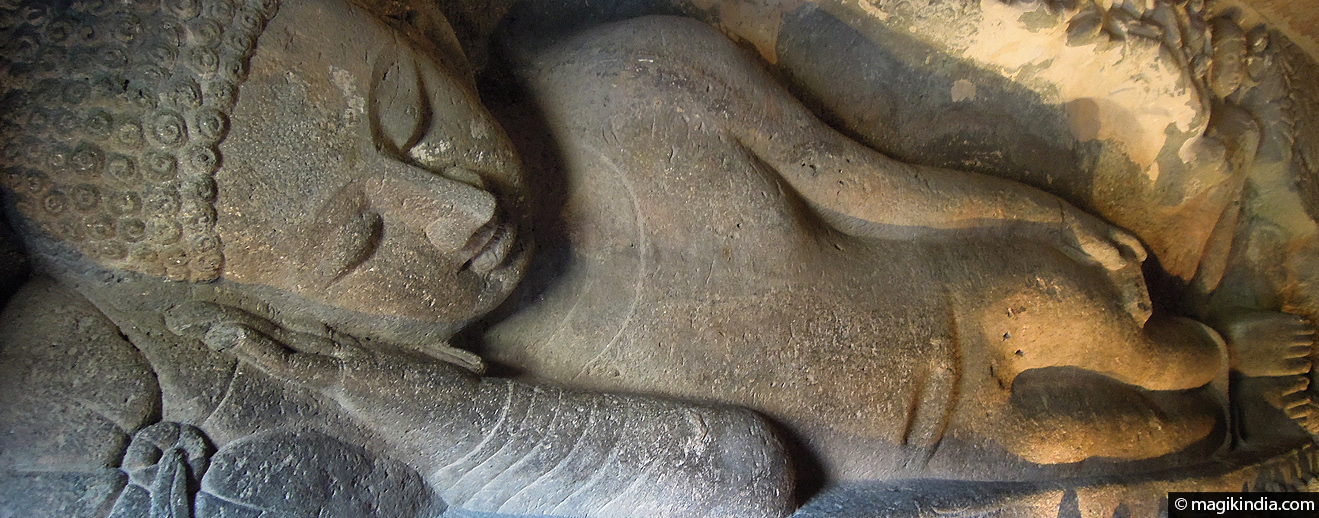
Ajanta caves, masterpieces of buddhist art
Ajanta, the long-hidden caves carved in the cliffs above a meander in the Waghora river now unveil their secrets to visitors. Inside, the life story and legends of the Buddha are told in magnificent frescoes and rock carvings, masterpieces of religious art whose impact once reached far beyond India’s borders.
The Ajanta caves, now a World Heritage site, were carved out in two distinct periods: in the 2nd and 1st centuries BCE and in the 5th and 6th centuries CE under the Gupta dynasty, when Buddhism was at its peak in India. The later, more elaborate caves are a stunning testimony to the development of Indian art and the decisive impact on it of India’s Buddhist community at that time.
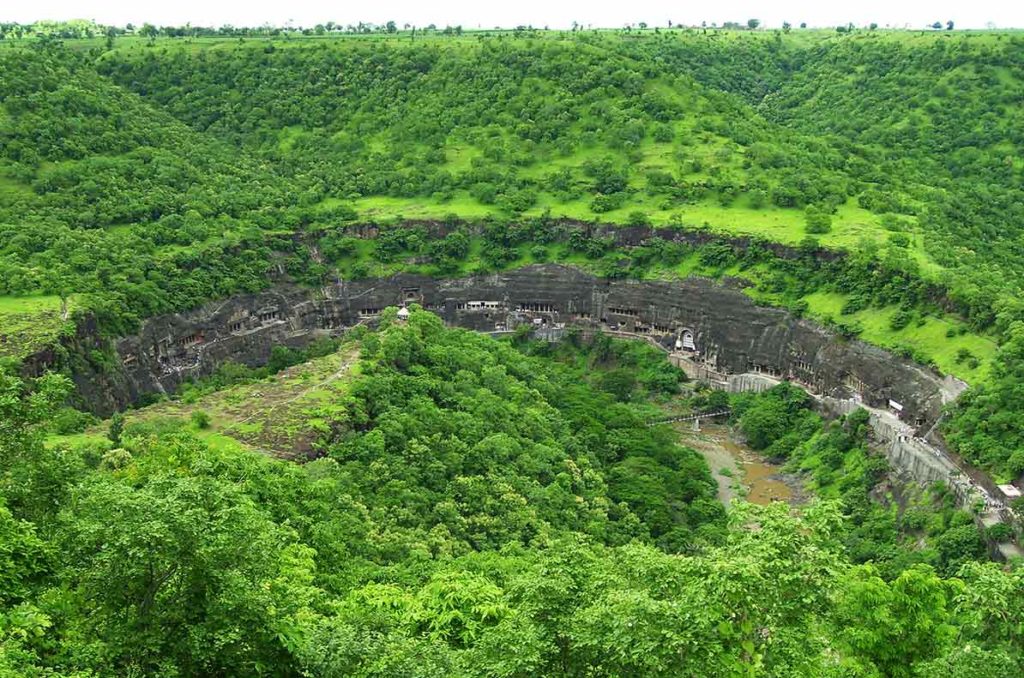
These 29 sumptuous Buddhist caves were hollowed out of the volcanic rock of a cliff on the south side of a U-shaped wooded gorge. Five of them were temples and 24 were monasteries. It is reckoned that some 200 monks would have lived there. The caves were later abandoned and forgotten until 1819 when they were accidentally rediscovered by British officers on a tiger hunting party.
The technical skill and delicacy of the Ajanta wall paintings represent a high point in Buddhist art and had a major influence on Buddhist temple art throughout India and in Southeast Asia (Java) for the next thousand years.
In the 7th century the caves were abandoned in favour of those at Ellora.
N.B: Some caves in Ajanta are closed or under restoration or are of little interest, I have kept, in this article, only the most elaborate. My favorite is cave 29, what is yours? 😉
Ajanta Cave 1
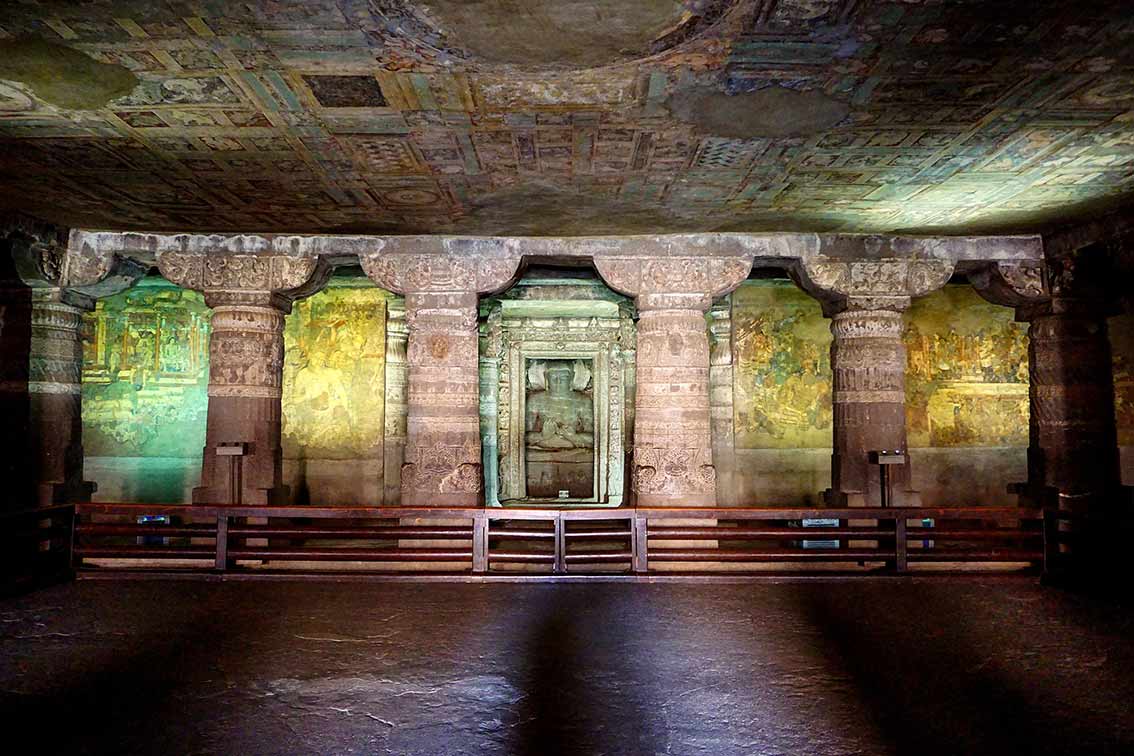
Cave 1, a vihara (monastery), is surely one of the most beautiful on the site. It has elaborate carved facades with scenes from the life of the Buddha as well as a number of decorative motifs.
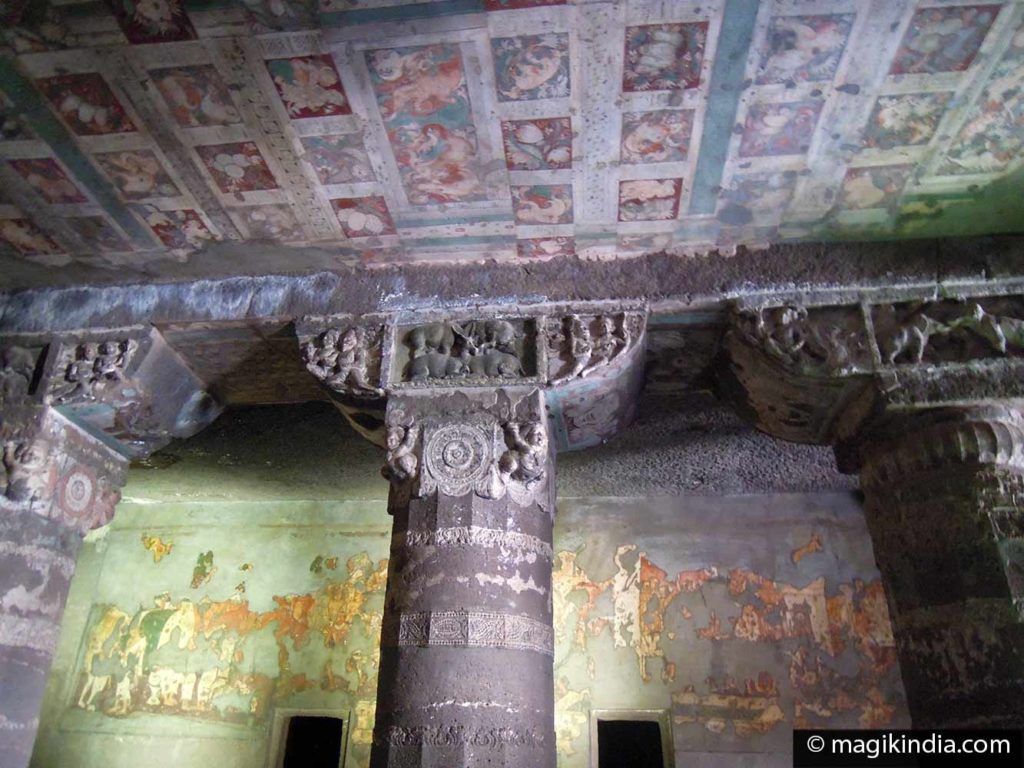
The mineral-based paintings harmoniously cover the walls and ceilings of the cave. The scenes depicted are mainly Jataka* stories and the life of Gautama Buddha. The two most famous images of Ajanta are found in this cave: they are those of the bodhisattvas Padmapani and Vajrapani painted on each side of the entrance to the sanctuary. Padmapani is the main form of Avalokiteshvara, one of the most revered bodhisattva of Mahayana Buddhism, while Vajrapani is an emanation of Vajradhara Buddha, its function is to destroy our delusions. * Popular and didactic account of the previous lives of the Buddha.
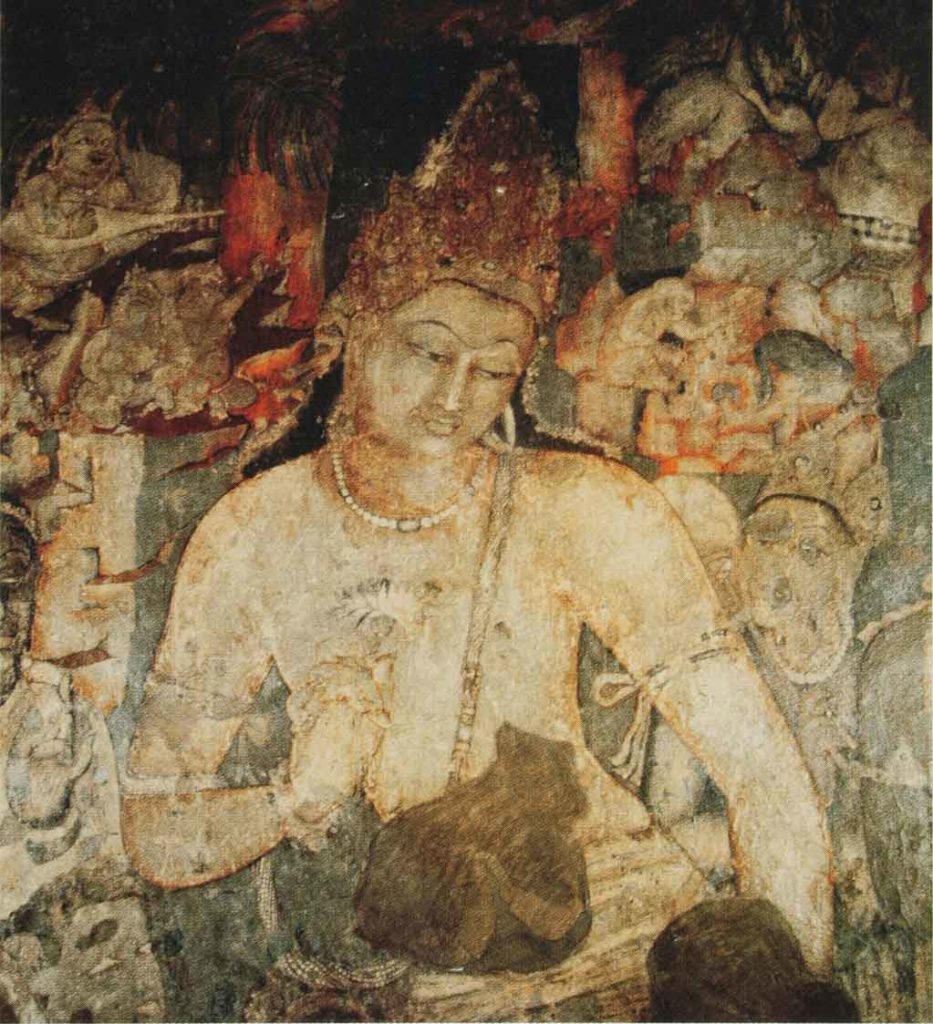
Ajanta Cave 2
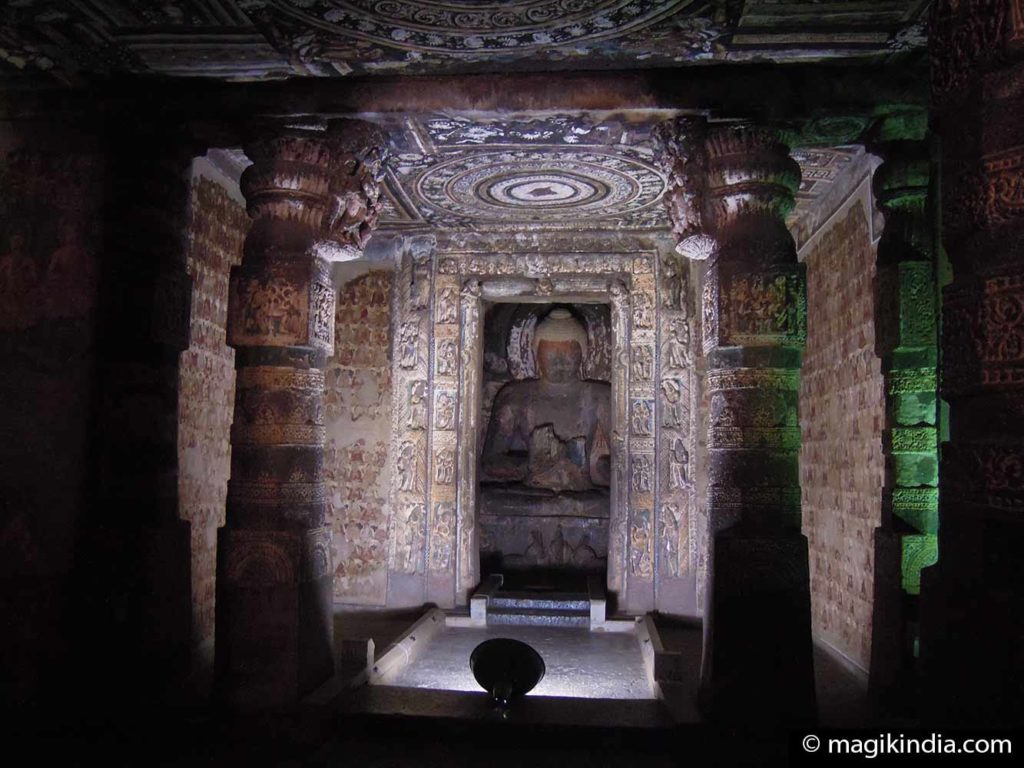
Cave 2, adjacent to cave 1, is also one of the most interesting of Ajanta with paintings in very good state of conservation.
There are a large number of women represented on these frescoes; note that of Hariti-Panchik, a scene of motherhood. The sanctuary contains a Buddha flanked by celestial nymphs and bodhisattvas.
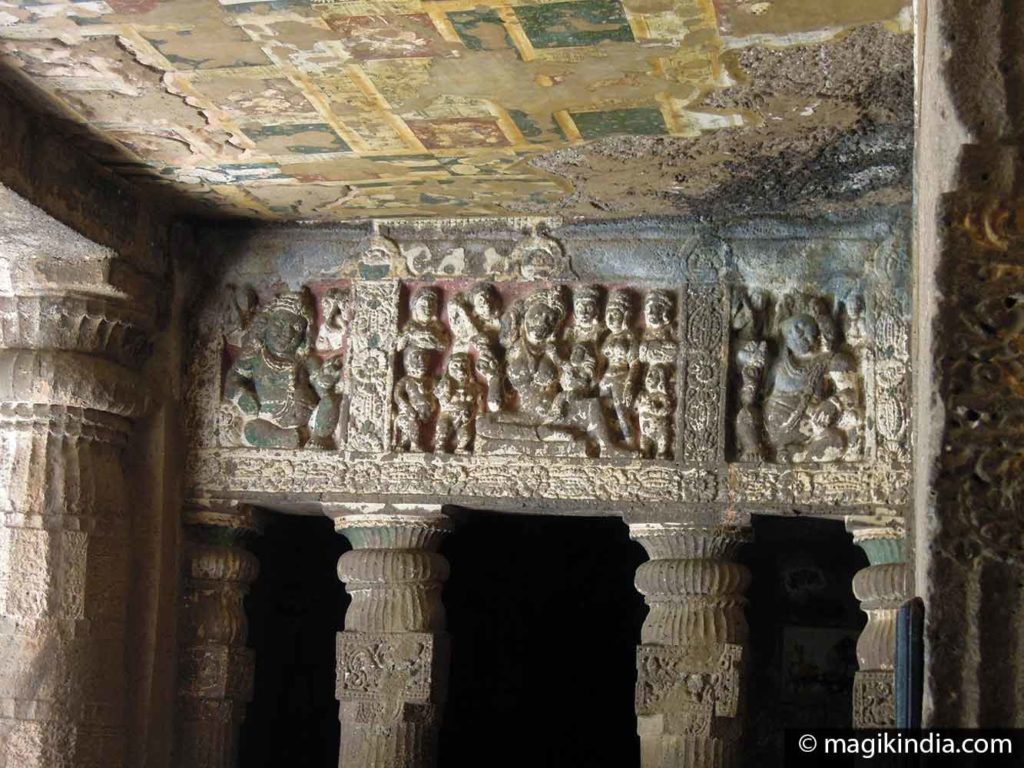
Ajanta Cave 4
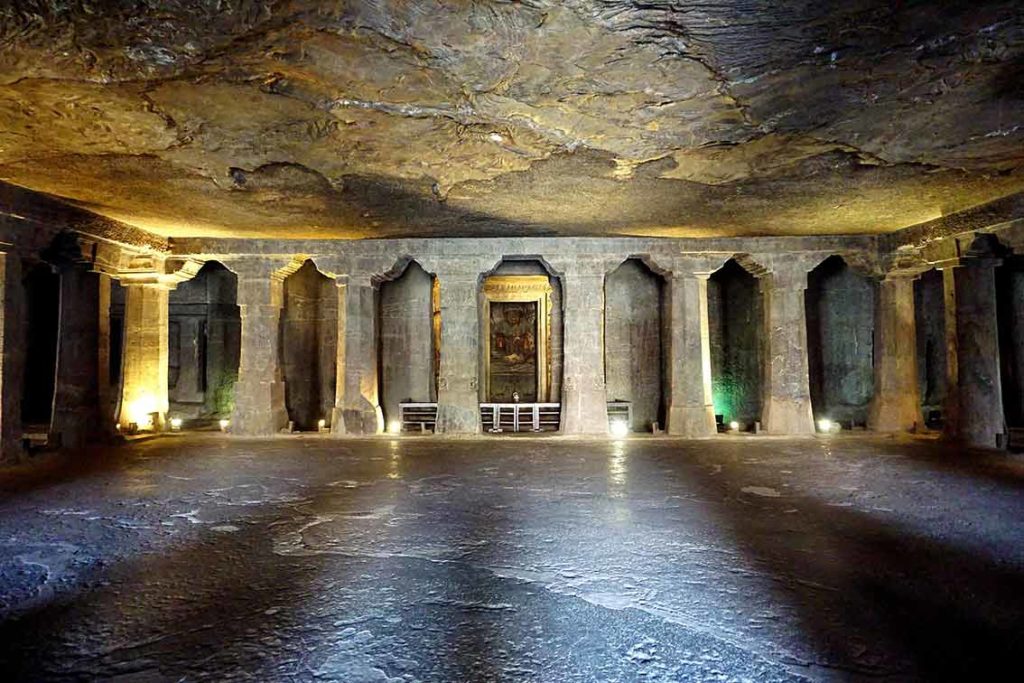
Cave 4 is the largest vihara in the group (35m × 28m), but has never been completed. It houses an image of the Buddha as a teacher, flanked by bodhisattvas and celestial nymphs hovering above. The door jamb and lintel are beautifully decorated with Buddha figures and the anteroom walls are decorated with six standing Buddhas, two of which are unfinished.

Cave 6
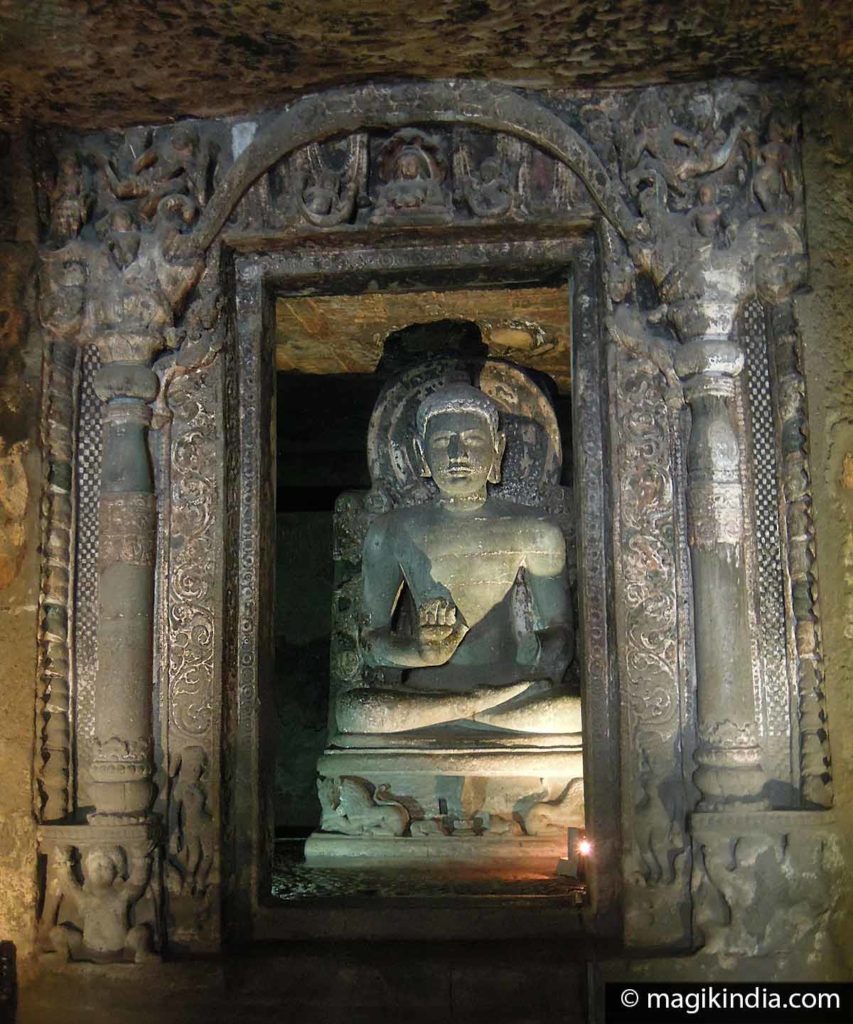
Cave 6 is the only two-story monastery on the Ajanta site. Both shrines present a Buddha in the posture of instructor. The frames of the sanctuary doors are finely carved with makaras and asparas as well as other mythical creatures.
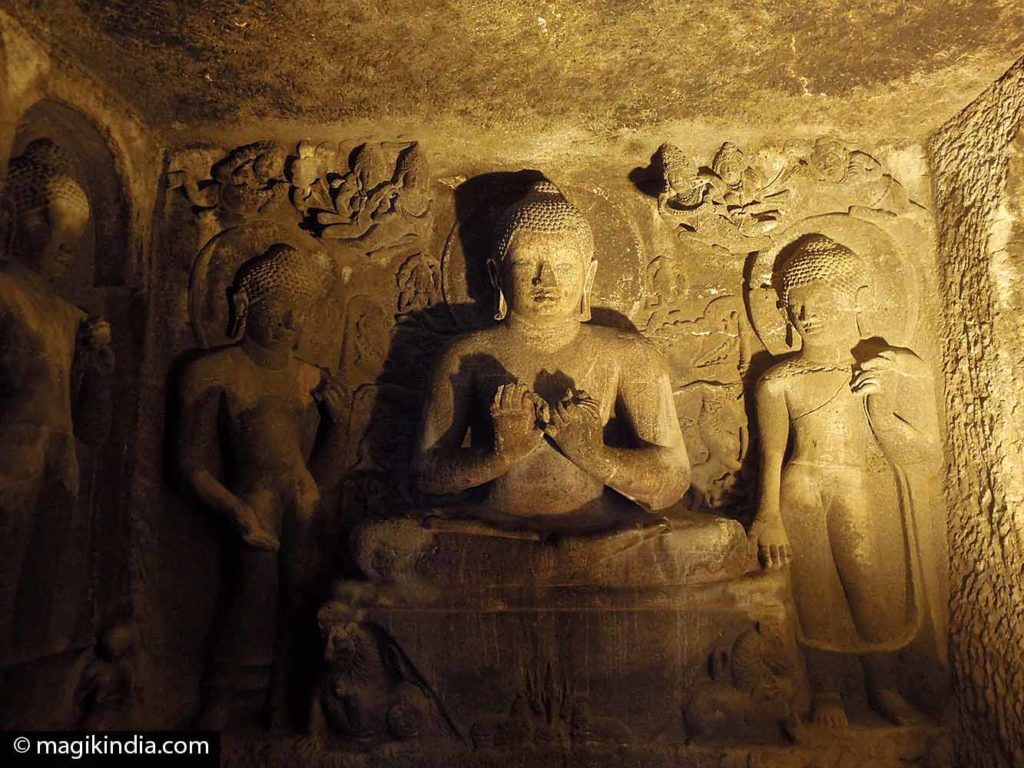
Cave 7
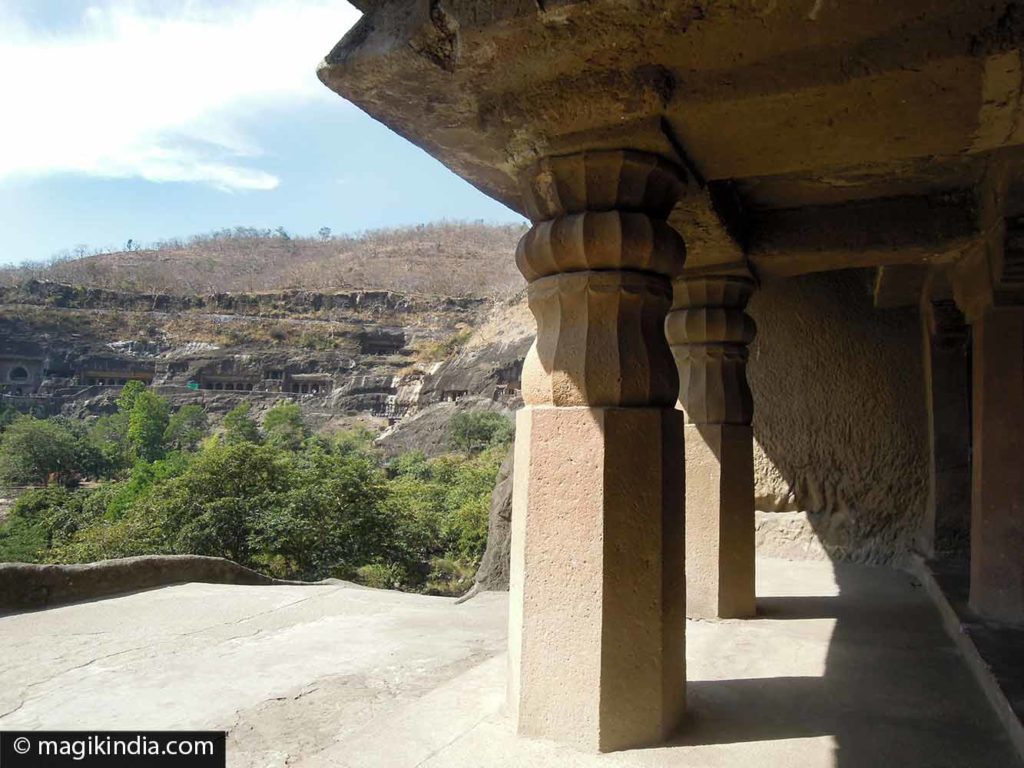
Cave 7 is also a monastery, but on one level with an eight-pillar veranda. This vihara consists of a sanctuary with a statue of the Buddha in the posture of instructor, a room with octagonal pillars and eight small rooms for the monks. Numerous finely carved panels relating various Buddhist themes such as the Naga Muchalinda, the story of the serpent (naga) who saved the Buddha from a flood during his long meditation in Bodhgaya, the Buddha’s place of awakening. All around the door of the sanctuary, we will also notice a scene with a multitude of Buddhas carved in various postures and facial expressions.
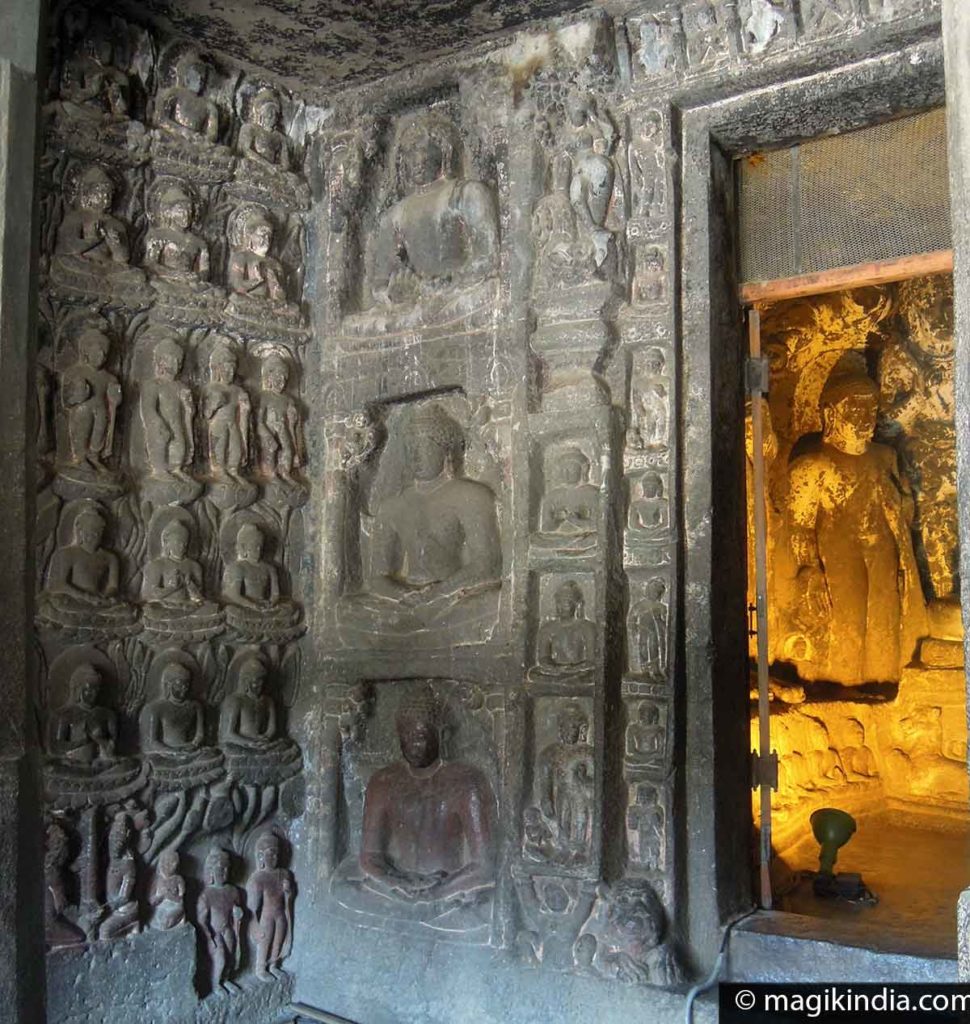
Ajanta Cave 9
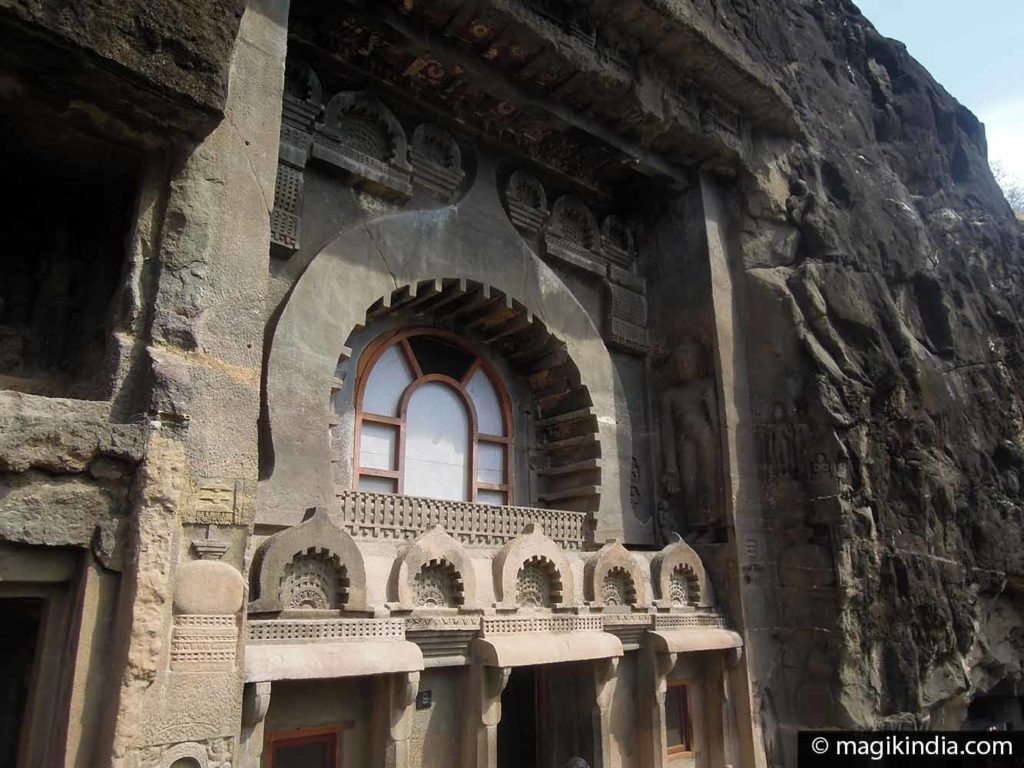
Cave 9 is an apse-shaped chaitya-griha (worship hall) from the 2nd century BCE belonging to the Hinayana phase of Buddhism. The front door is particularly neat with a horseshoe opening and two side windows. The nave is flanked by side aisles (pradakshina) separated by a row of 23 pillars and a stupa, object of worship. Above the pillars and also behind the stupa are colorful paintings of the Buddha and on the walls of the friezes of Jataka tales.
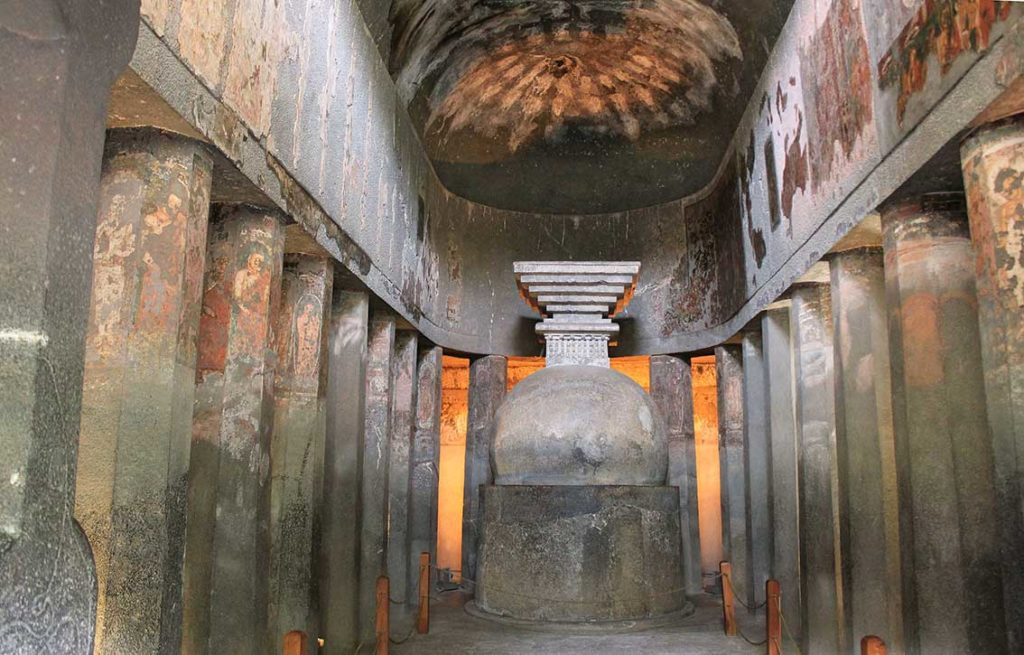
Cave 10
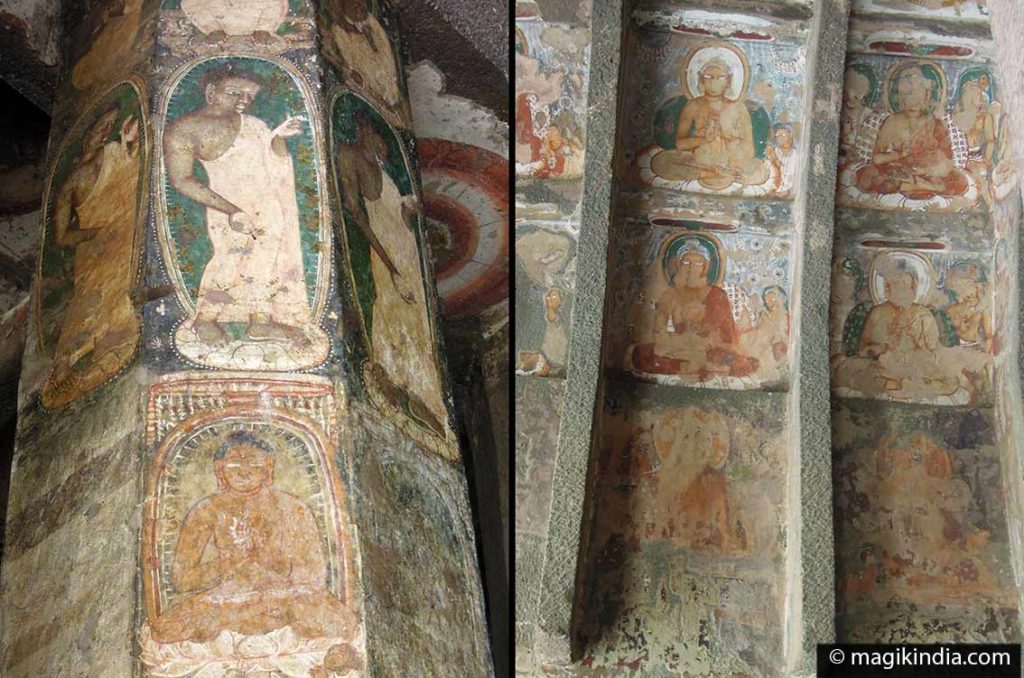
Cave 10 looks like cave 9, it is a large prayer hall or Chaitya which is dated from around the 1st century BCE. It is one of the oldest along with Cave 12. It was also the first to be discovered in April 1819, by British army officer John Smith.
The cave consists of a large central apse hall with a row of 39 octagonal pillars leading to a stupa. The paintings are numerous and of two periods, many telling the tales of Jataka including that of Shyama Jataka:
Shyama, the Buddha in a previous life, was the only son of a hermit and his wife, both blind, who therefore depended entirely on him. Shyama responded to their needs with great devotion and was a perfect example of filial piety. One day, while Syama was going to draw water from the river, he was wounded by an arrow shot by the king of Benares who was hunting. Due to the king’s penance and the grief of Shyama’s parents, Indra (the king of all gods) intervened and allowed Shyama to be healed and he restored his sight to his parents.
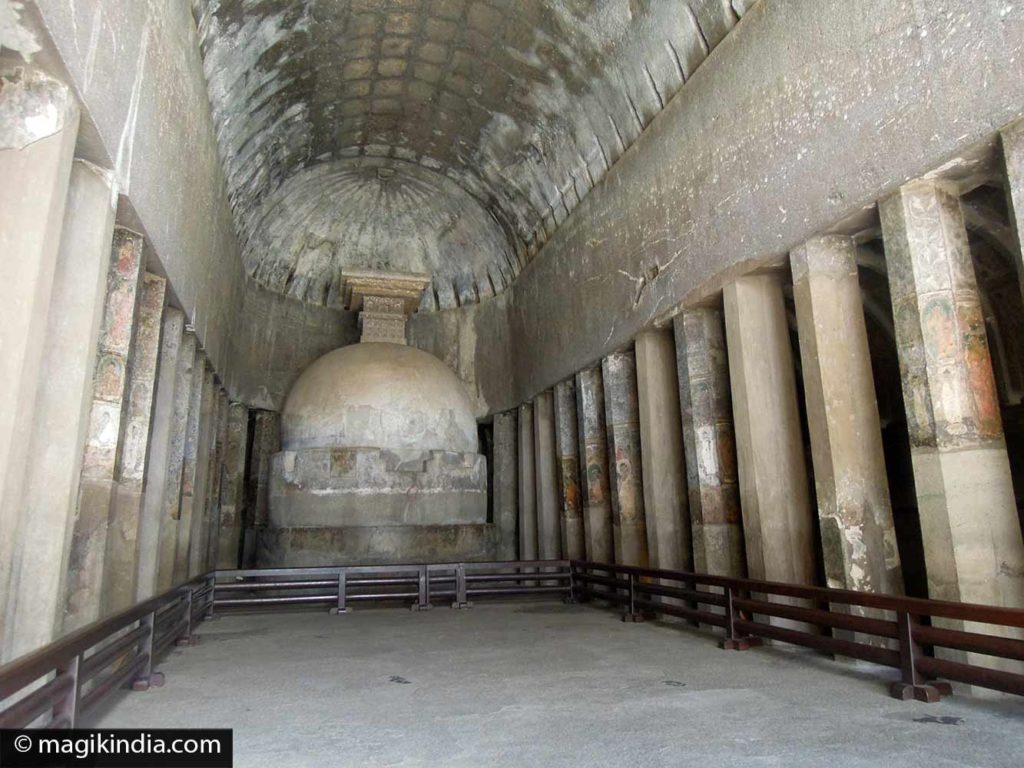
Cave 11
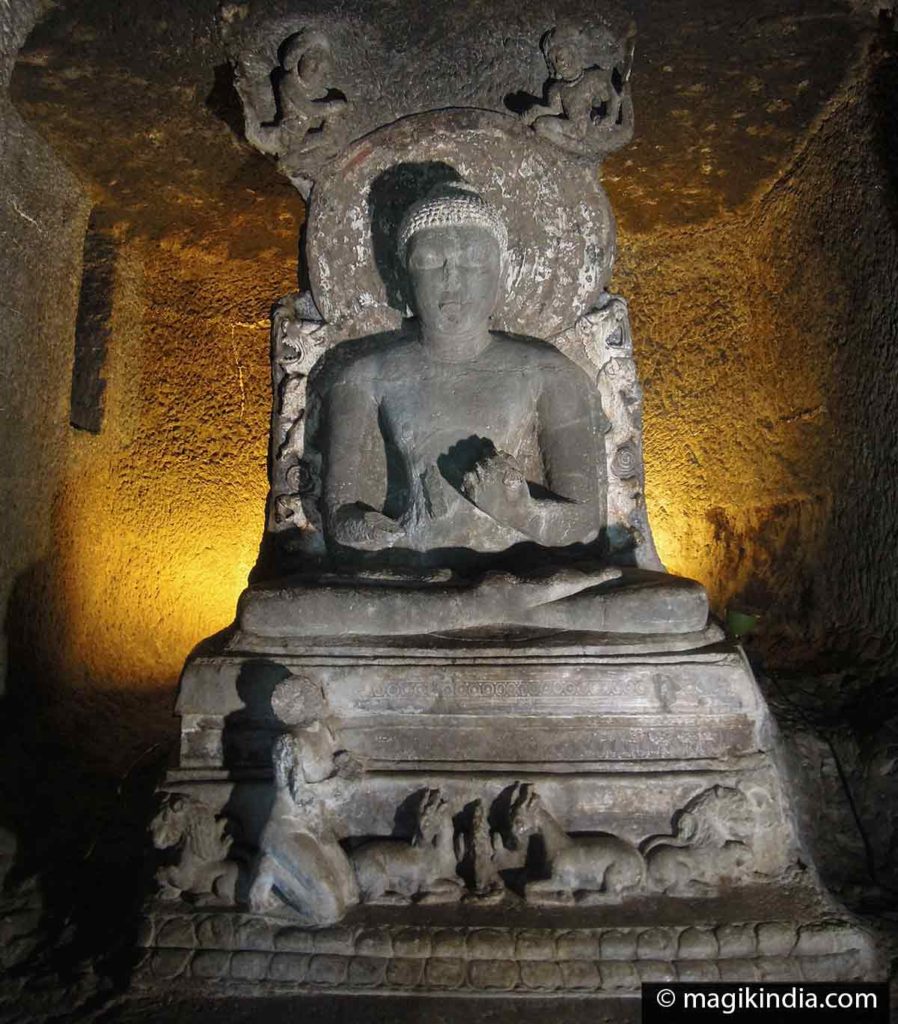
Cave 11 is a monastery from the end of the 5th century AD, the sanctuary of this cave is among the last structures built in Ajanta. The veranda ceiling shows traces of floral patterns and eroded reliefs. Inside, the cave consists of a hall with a long stone bench opening onto six rooms. Another pillared veranda ends with a sanctuary with a Buddha seated against an unfinished stupa.
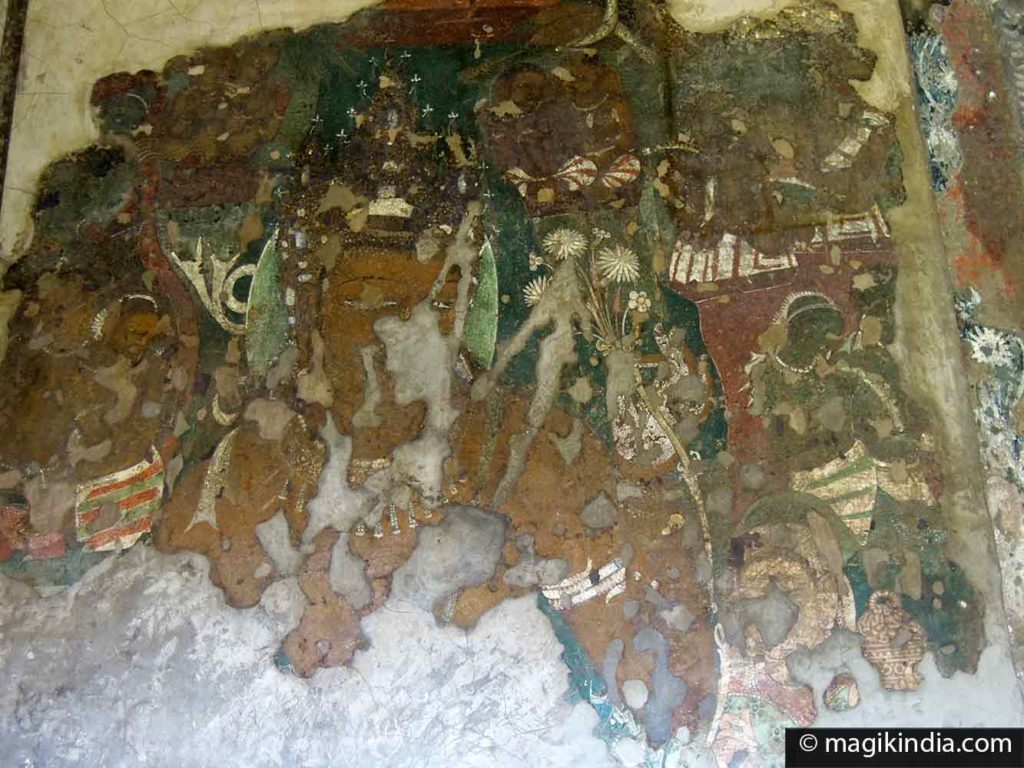
Ajanta Cave 16
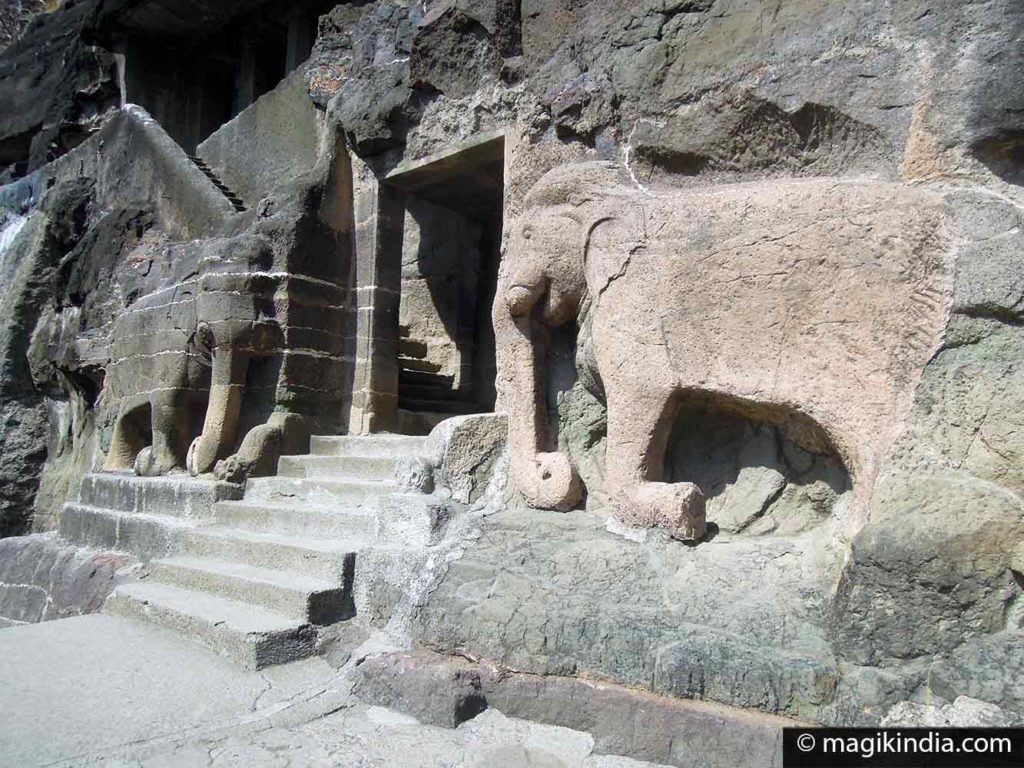
We enter cave 16 by a flight of steps flanked by two elephants. This Mahayana monastery, occupies a privileged position, roughly in the middle of the site and was sponsored by Varahadeva, Minister of King Vakataka Harishena (475 – 500 CE). His wish was that “the whole world should enter a peaceful and noble state without grief or illness”. This cave would have influenced the architecture of the entire site.
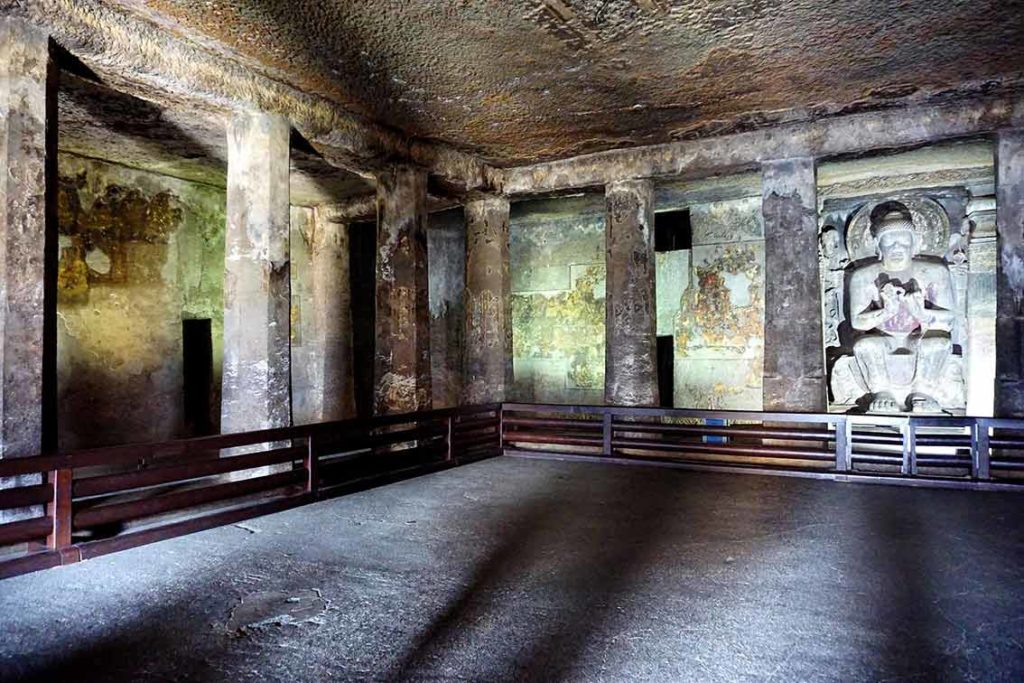
There are many paintings in cave 16, there are various Jataka tales and several frescoes on the life of the Buddha, including one that illustrates the conversion of Nanda, the brother of the Buddha, into a Buddhist monk. While Nanda wanted to lead a sensual life with the woman he had just married, the Buddha took him to paradise and later to hell to show the spiritual dangers of a sensual life.
Ajanta Cave 17
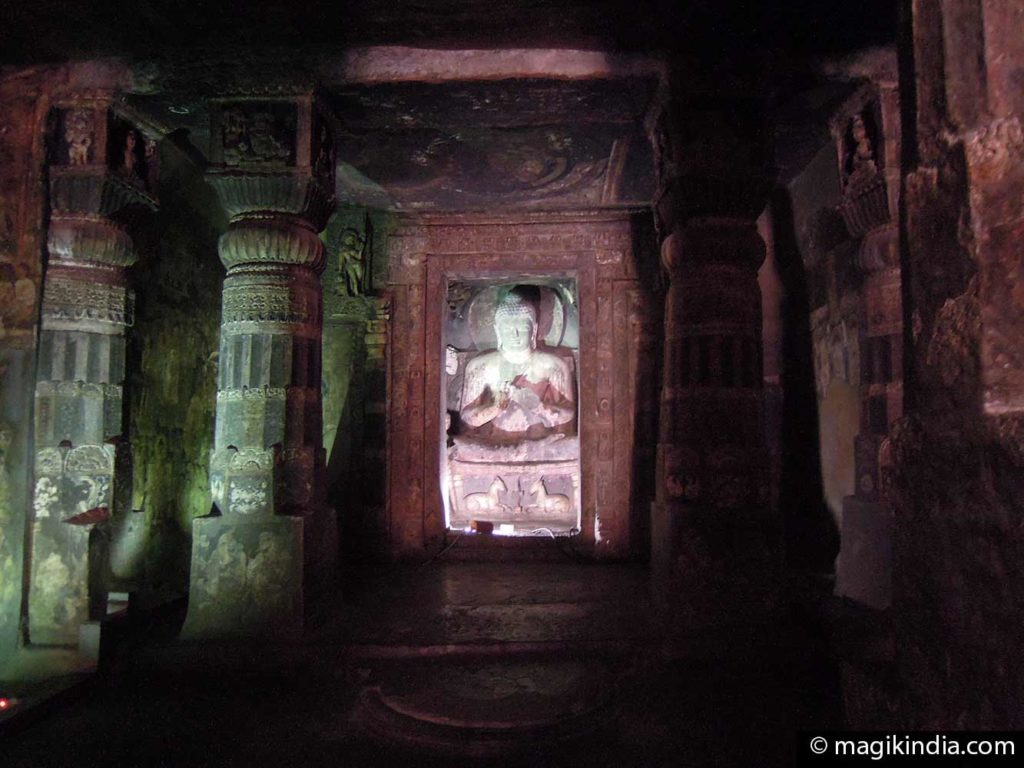
Cave 17, another vihara of Ajanta, was sponsored by King Upendragupta and, in a long inscription on one of the walls of the cave, he explains ‘modestly’ that he spent a lot of money in order to build this vihara, bringing much of satisfaction to the devotees’. In total, Upendragupta is known to have sponsored at least five Ajanta caves.
This monastery houses paintings, which are the best preserved of all the caves on the site. There are some thirty major frescoes representing the Buddha in various forms and postures, several tales of Jataka, but also scenes from everyday life such as a princess putting on makeup or a lovingly seated couple.
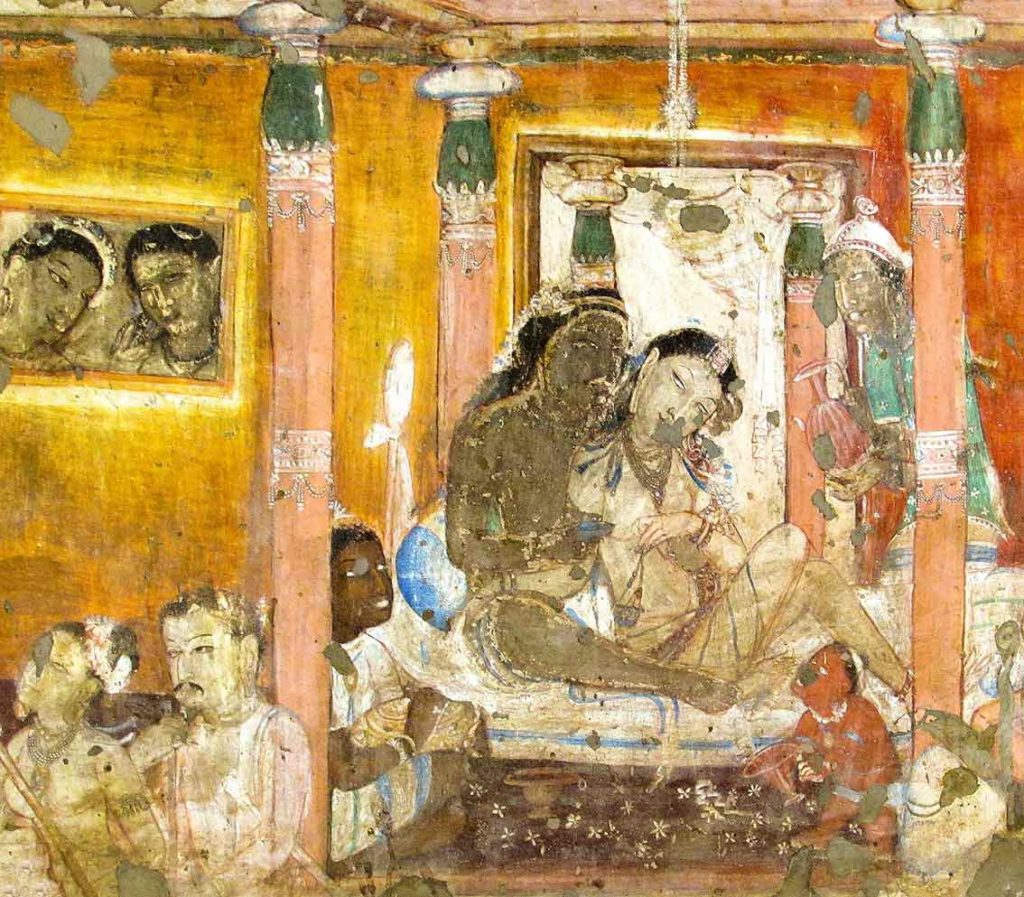
Cave 19
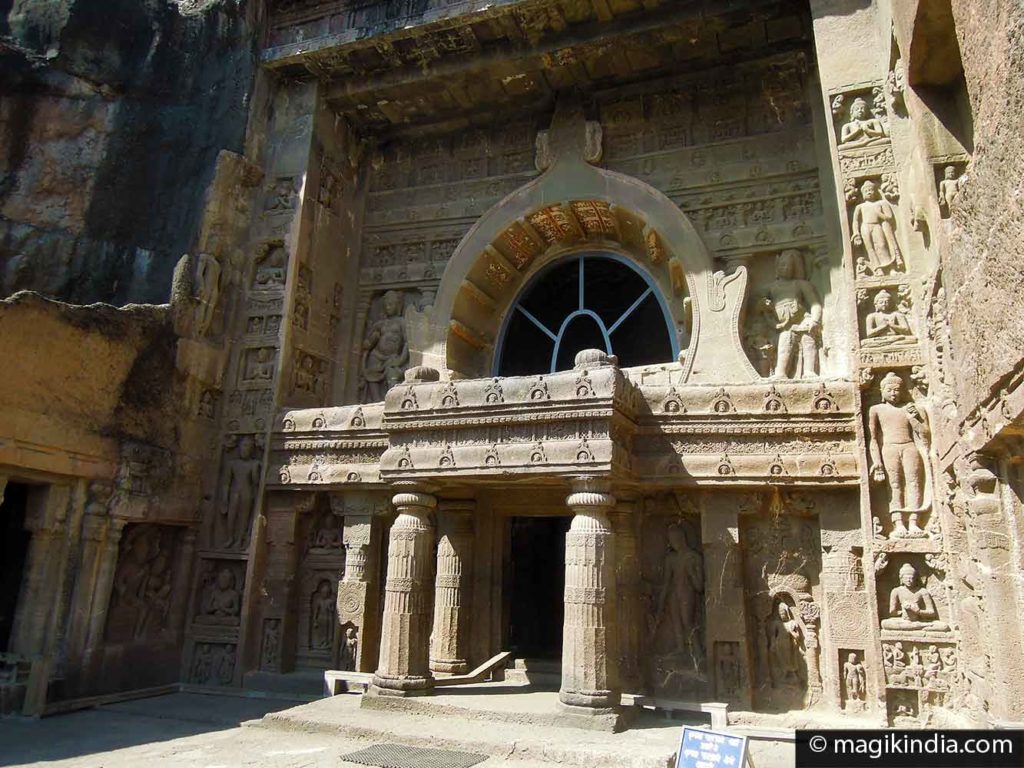
Cave 19 is a worship hall (chaitya griha) dating from the 5th century AD. It is one of the most beautiful specimens of Buddhist art. The colonnaded entrance particularly attracts attention with its horseshoe window and its rich sculptures.
The worship hall is apse, 15 pillars divide it into two aisles with a nave that lead to a standing Buddha. The round pillars have floral reliefs and are topped with finely carved capitals.
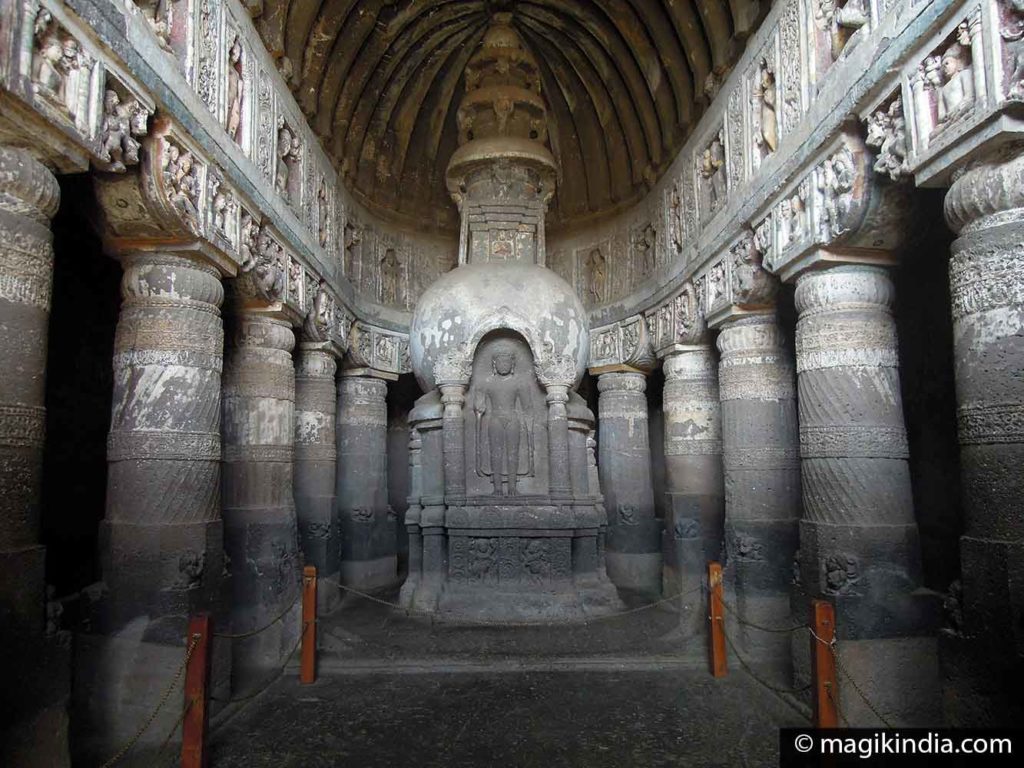
Ajanta Cave 26
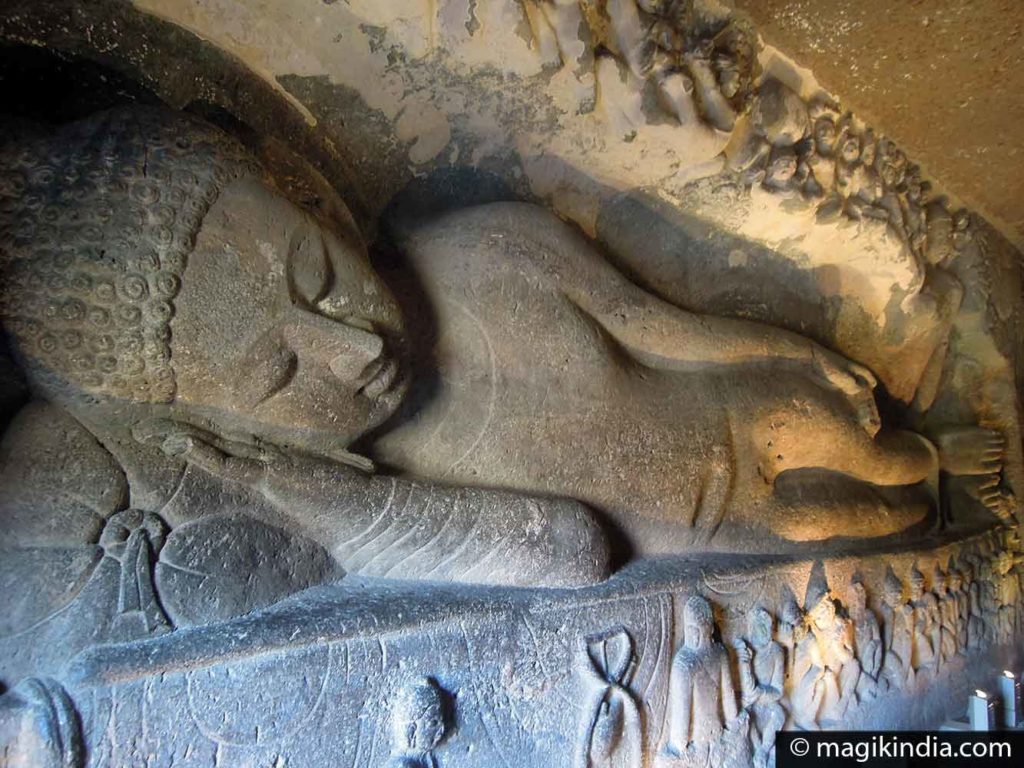
And, I saved the best for last! The cave 26, which is a chaitya griha from the end of the 5th century AD, is for me the most beautiful cave on the Ajanta site; it includes much more elaborate sculptures than the others.
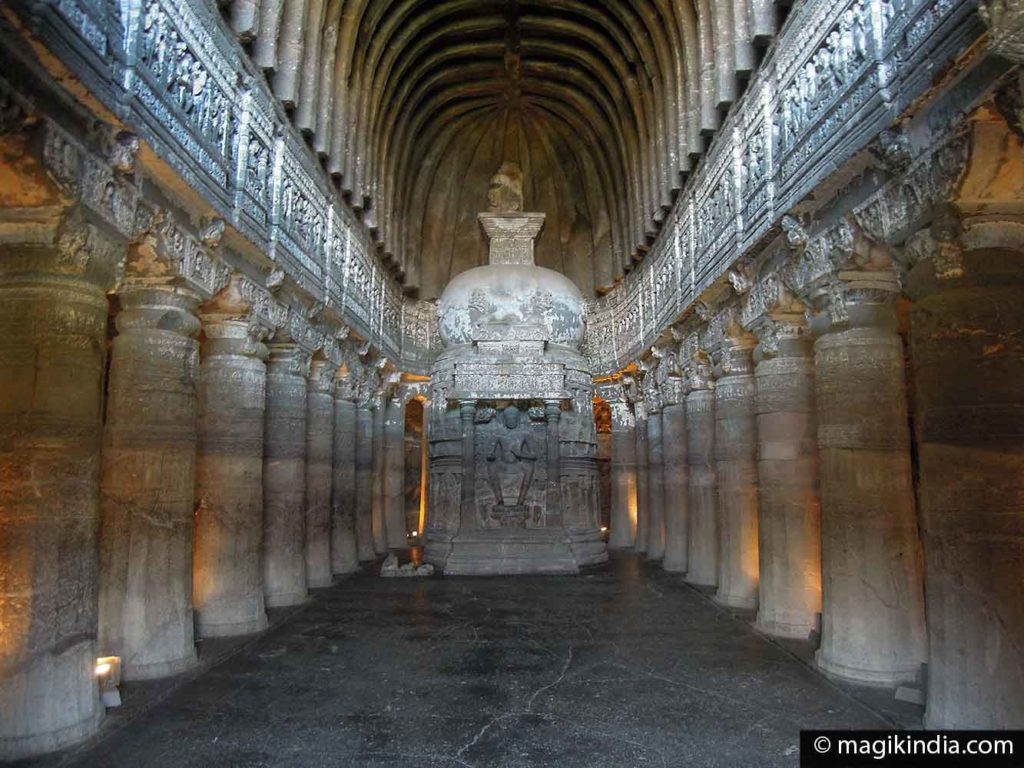
The cave consists of an apse hall with side aisles for the circumambulation, which are covered with magnificent panels carved with Buddhist legends. The two major works include the Mahaparinirvana of the Buddha (reclining Buddha) on the wall, followed by the legend called the ‘temptations of Mara’.
Mara is, in Buddhism, the evil and tempting spirit who tried to prevent Siddhartha Gautama from reaching enlightenment when he meditated under the Bodhi tree.
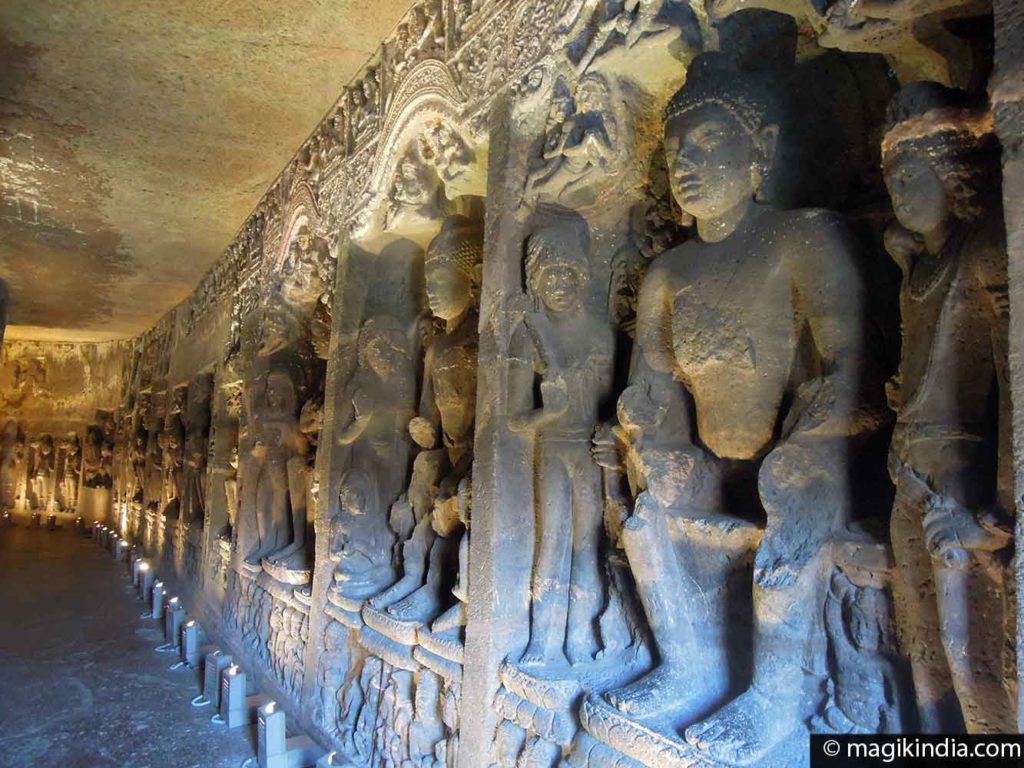
On the fresco known as ‘the temptations’, we see the girls of Mara (standing below the Buddha) trying to seduce him with light outfits and seductive postures. On each side of the Buddha there are the armies of Mara who try to distract him by threatening him. In the upper right corner you can see the image of a Mara man who looks frustrated as he was not able to interrupt the meditation of the Buddha.
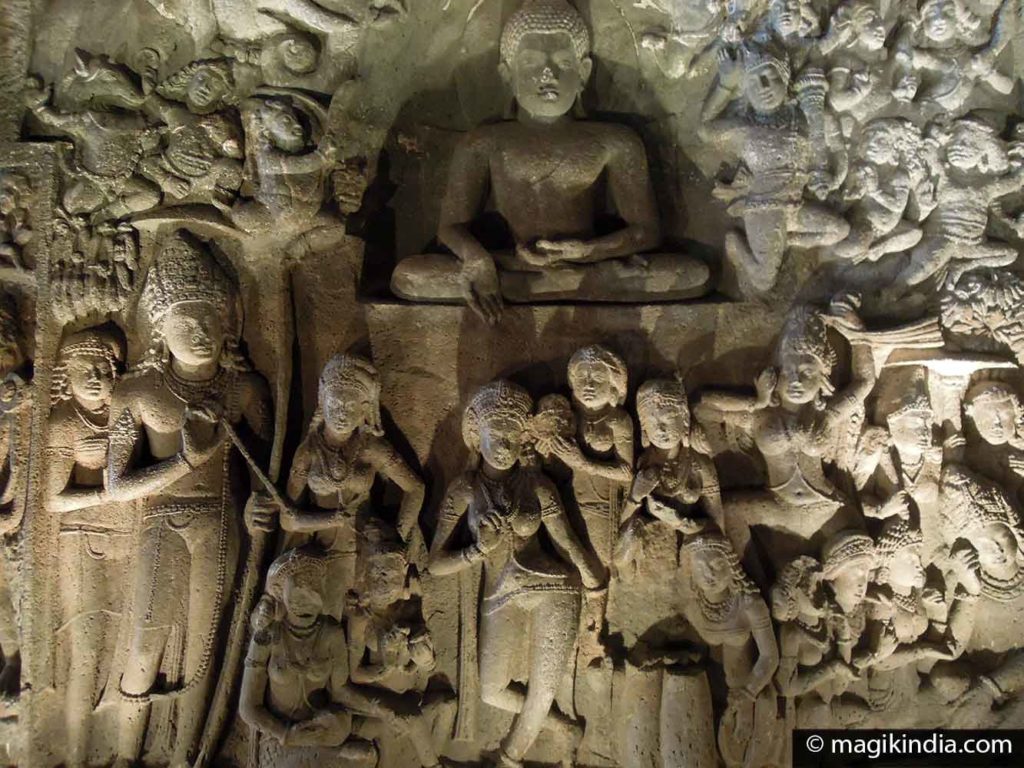
In the center of the apse, there is a stupa carved in the rock with an image of the preaching Buddha surmounted by a torana (arch) on three levels and apsaras are carved on the ‘stupa anda’ (the hemispherical part of the stupa, in egg shape). At the top of the Stupa is a harmika (a small platform with a balustrade located at the very top of a stupa) with nine levels, symbol of samsara, the nine heavens of Mahayana cosmology.
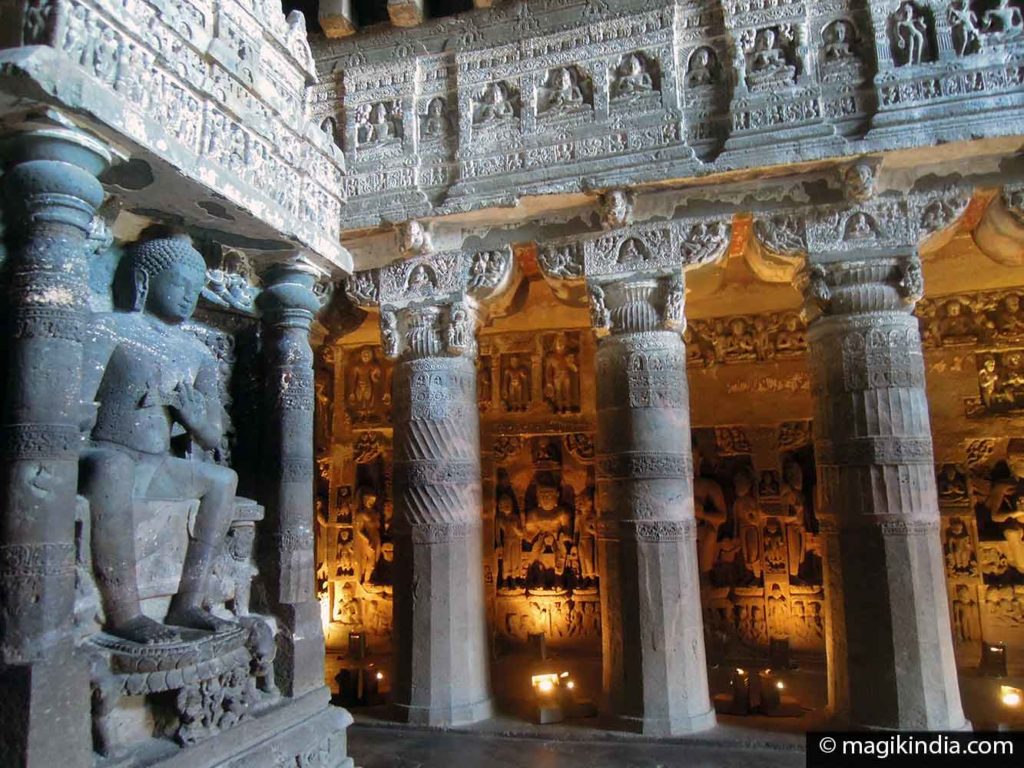
If you liked Ajanta’s site, you will be blown away by Ellora’s! Click on this link to visit the other wonders of Maharashtra state!
VISIT ELLORA CAVES
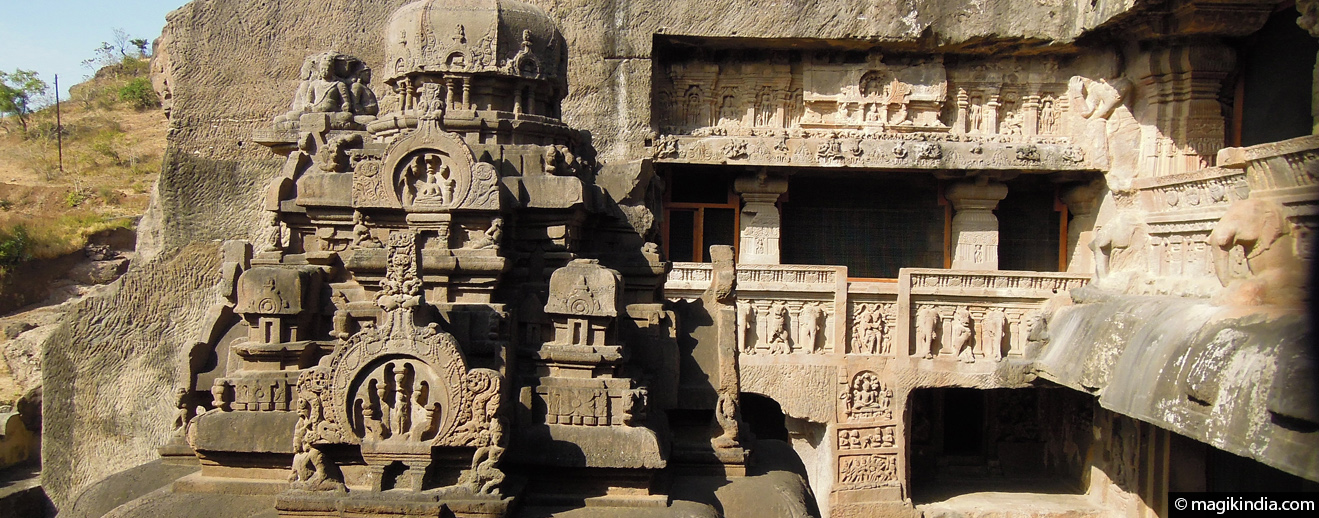
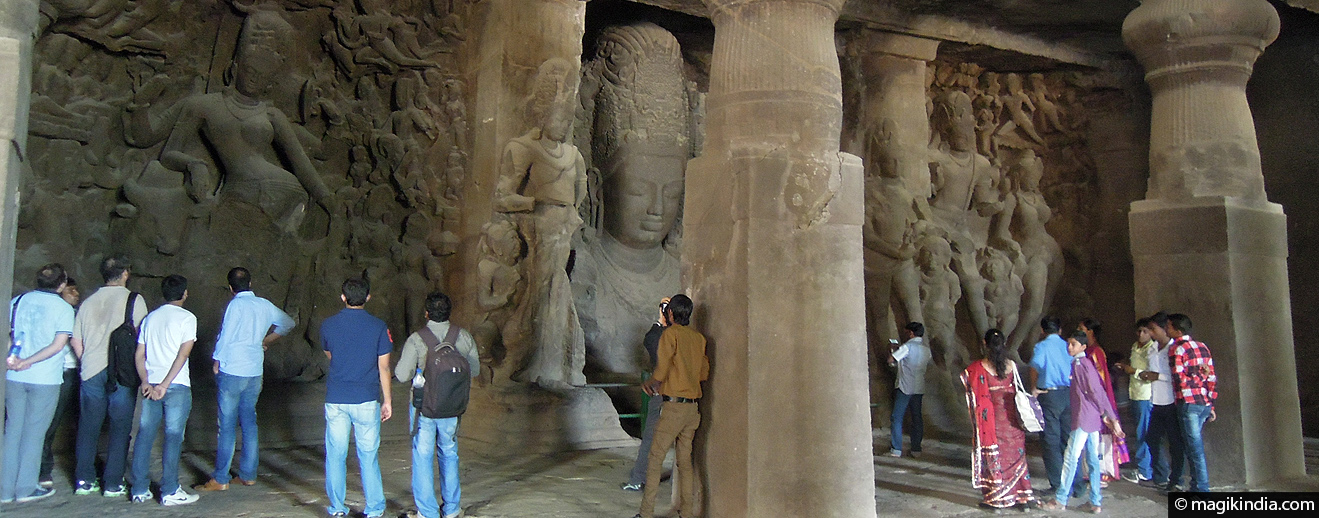
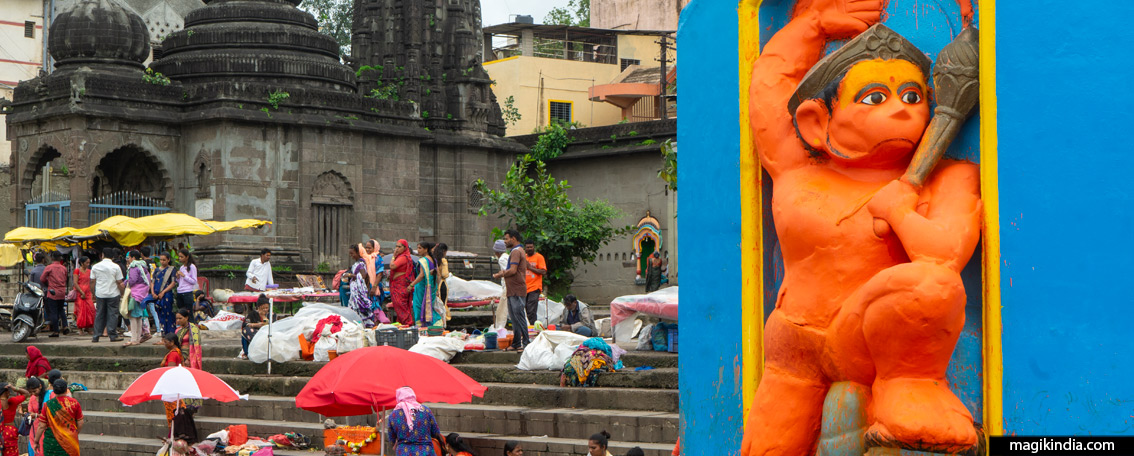
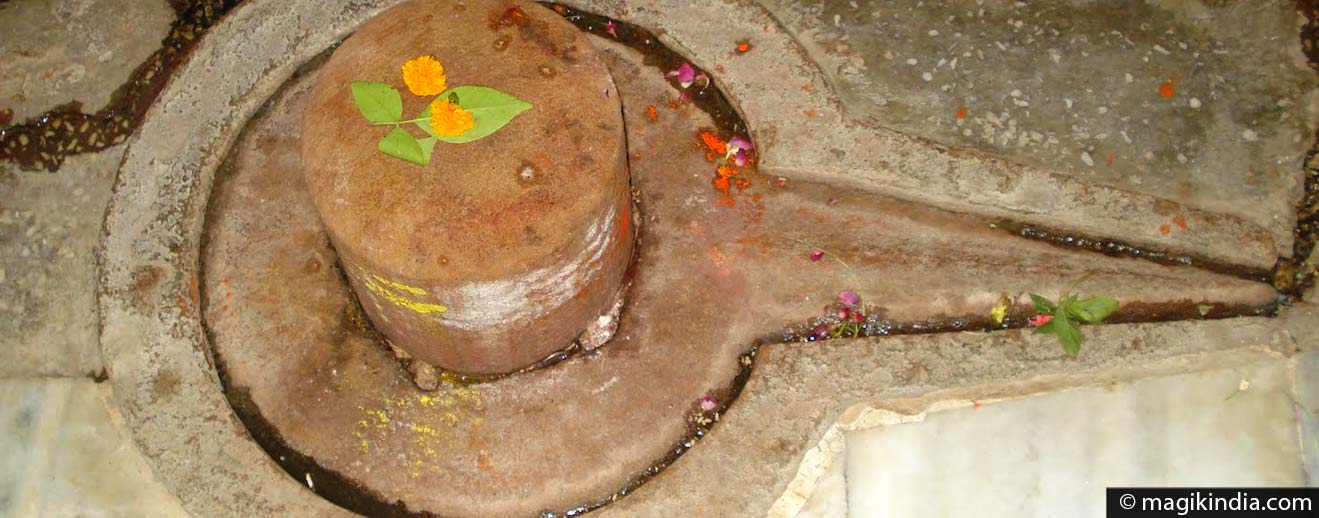
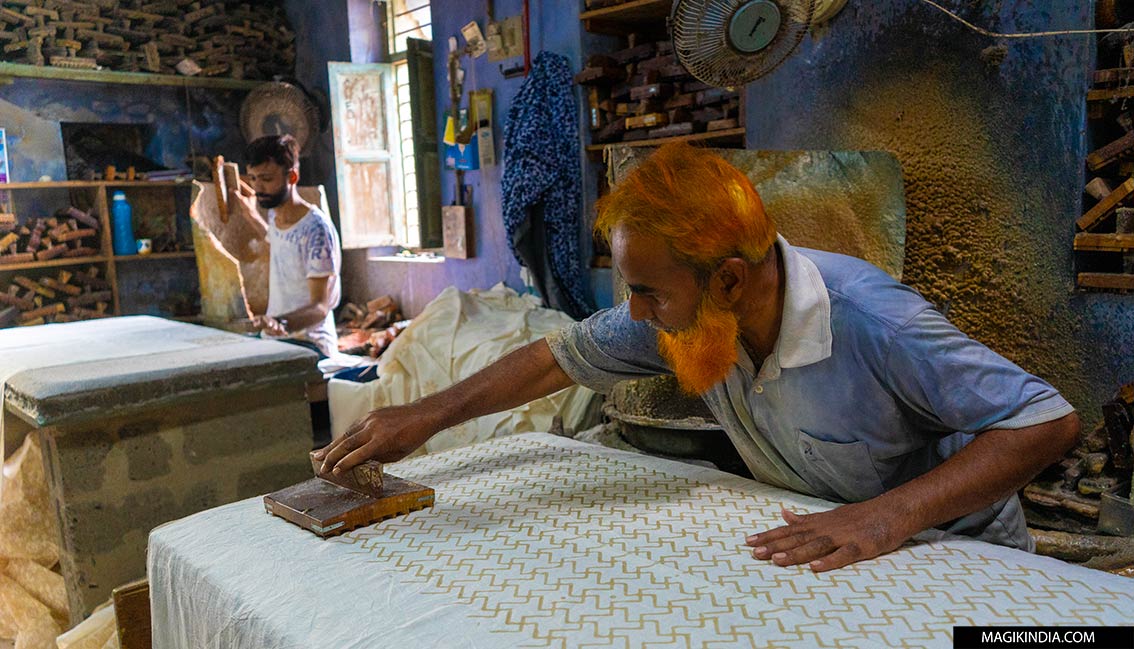

An amazing find, a place of much peace and memories of enlightenment.
Just it is indeed ! best regards, Mathini